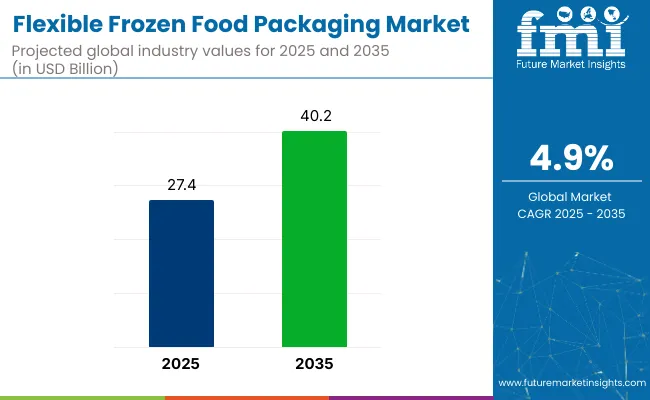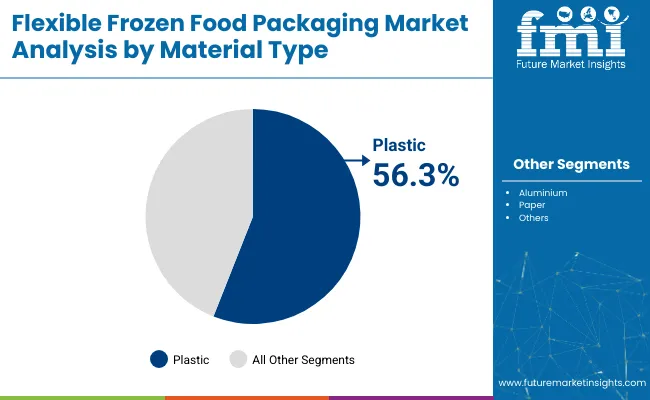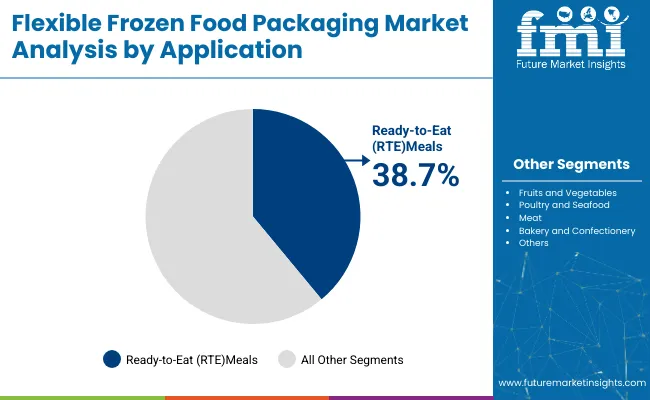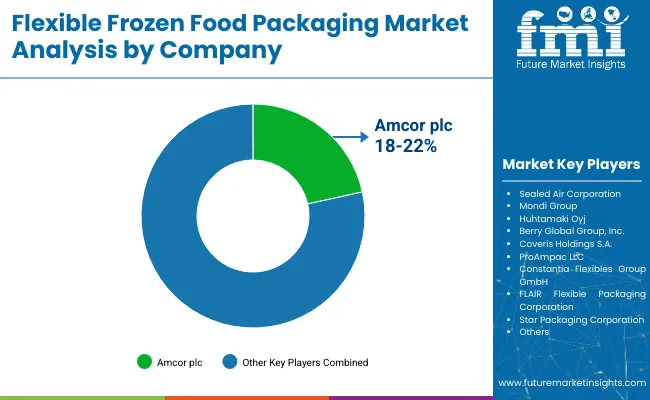The global flexible frozen food packaging market is projected to grow from USD 27.4 billion in 2025 to approximately USD 40.2 billion by 2035, reflecting a robust CAGR of 4.9% over the forecast period. This expansion is driven by increasing consumer demand for convenient, high-quality frozen meals and snacks, coupled with advancements in packaging technologies that offer superior barrier protection and cost efficiency.

| Metric | Value |
|---|---|
| Estimated Size (2025E) | USD 27.4 billion |
| Projected Value (2035F) | USD 40.2 billion |
| CAGR (2025 to 2035) | 4.9% |
Flexible packaging solutions, such as pouches, wraps, and bags, are gaining traction over traditional rigid containers due to their lightweight, space-saving, and durable nature. Additionally, the shift towards sustainable packaging alternatives, including recyclable films and biodegradable options, is further propelling market growth.
In 2025, Amcor launched its Liquiflex AmPrima mono-material pouches across Europe, targeting the bulk foodservice sector with sustainable packaging solutions suitable for products like sauces, dressings, frozen vegetables, and proteins. These pouches are designed to be recyclable in polyethylene (PE) streams and offer significant environmental benefits, including up to a 79% reduction in carbon emissions, 84% less water usage, and a 75% decrease in non-renewable energy consumption compared to traditional packaging formats.
These figures are based on Amcor’s ASSET life cycle assessment methodology, certified by The Carbon Trust. The pouches also support the integration of food-contact post-consumer recycled (PCR) materials and can be equipped with pump or spout dispensers, making them ideal as refill solutions for commercial kitchens and foodservice operators.
Recent innovations in flexible frozen food packaging include the development of high-barrier films that offer enhanced moisture and oxygen resistance, thereby extending the shelf life of frozen products. Technological advancements have led to the creation of microwaveable and steam-vented pouches, catering to the convenience-oriented consumer segment. Moreover, the integration of smart packaging features, such as QR codes and freshness indicators, is gaining momentum, providing consumers with real-time information about product quality and safety.
The market has been segmented based on material type, product type, application, distribution channel, and region. By material type, plastic, aluminum, paper, and other material types are utilized to deliver cold-chain integrity, moisture resistance, and extended shelf life under sub-zero conditions.
Product types include bags, pouches, wraps, and films each designed for specific pack sizes, sealing formats, and automation compatibility. Application segmentation comprises ready-to-eat meals, fruits and vegetables, poultry and seafood, meat, and bakery and confectionery, reflecting the broad utility of flexible packaging in frozen categories.
Distribution channels include convenience stores, supermarkets/hypermarkets, online stores, and other distribution formats, accounting for both impulse and planned purchases across modern and traditional retail. Regional segmentation spans North America, Europe, South America, Asia Pacific, and the Middle East and Africa to address varying cold-chain infrastructure, packaging compliance regulations, and frozen food consumption behaviors.

The plastic segment is projected to lead the material type category with a 56.3% share in the flexible frozen food packaging market by 2025, primarily due to its superior barrier properties, lightweight structure, and compatibility with high-speed form-fill-seal operations.
Materials such as polyethylene (PE), polypropylene (PP), and polyethylene terephthalate (PET) offer excellent resistance to moisture, oxygen, and freezer burn ensuring optimal preservation of frozen food products over extended shelf lives. Plastic laminates enable the formation of flexible pouches, wraps, and bags that are puncture-resistant and retain seal integrity even under sub-zero conditions.
Moreover, advancements in co-extruded films, peelable seals, and microwaveable designs have expanded the utility of plastic-based packaging across both single-serve and bulk formats. The growing demand for tamper-evident, resealable, and printed flexible packaging formats especially in frozen fruits, vegetables, seafood, and meat-further reinforces plastic’s dominance. In addition, major brands and private labels are increasingly exploring mono-material films and recyclable PE/PP structures to meet evolving regulatory and sustainability targets across North America, Europe, and APAC.

The ready-to-eat (RTE) meals segment is expected to lead the application category with a 38.7% share in 2025, underpinned by rising consumer demand for time-saving, microwave-ready food options across urban and working-class populations. RTE frozen meals-ranging from ethnic dishes and pasta bowls to breakfast platters and protein-rich entrees-are heavily reliant on flexible packaging for portion control, convenience, and extended frozen storage.
Flexible pouches and trays used in this segment offer dual-functionality: they preserve food quality during frozen storage and allow direct microwave or oven reheating without transferring the contents. Packaging formats are being optimized for features like steam vents, dual compartments, resealable zippers, and clear windows to enhance both functionality and visual appeal.
The post-pandemic consumer shifts toward at-home dining, increased penetration of D2C meal kit platforms, and retail expansion of frozen gourmet and organic meal lines have accelerated the growth of this segment. Food safety regulations and labeling requirements have also prompted innovations in flexible packaging that incorporate anti-fog coatings and high-resolution branding for better shelf differentiation.
As convenience continues to drive consumer behavior in the food industry, flexible packaging for ready-to-eat meals is positioned as the highest-impact application, attracting investment from both global food processors and regional private-label brands.
Stringent Food Safety Regulations, Environmental Concerns, and Material Durability
The flexible frozen food packaging market has been facing some challenges, as there are stringent food safety regulations that restrict the use of certain packaging materials, as well as storage conditions, which vary from one food type to another, and can pose a risk of contamination.
FDA, EFSA and HACCP requirements must be met for frozen food packaging to be protected from moisture, oxygen exposure and bacterial growth. The environmental issue is also another hurdle that flexible packaging faces as traditional plastic-based packaging adds to the waste that is piling up.
The increasing demand for sustainable, biodegradable and recyclable materials is challenging producers to come up with sustainable solutions without compromising on the performance criteria. Material durability is also such a challenge, as frozen flexible packaging should tolerate severe temperatures, avoid freezer burns and also it should keep food freshness for extended storage periods.
Growth in Sustainable Packaging, Smart Packaging Innovations, and E-Commerce Demand
However, the flexible frozen food packaging market is also poised for robust growth fueled by increasing demand for sustainable packaging, demand for smart packaging solutions, and the growing adoption of online grocery shopping.
There is a one-step trend toward developments towards bio-based films, recyclable (or multi-layered) packaging and compostable alternatives, as brands are looking to limit plastic interrogation. Smart packaging innovations, like those that employ temperature-indicating sensors or QR bar-code traceability, are facilitating the rise of more secure food systems.
Rising disposable income level coupled with the increasing demand for frozen meal kits, ready-to-eat meals, and direct-to-consumer food delivery services, are other factors driving the market demand for flexible frozen food packaging with long shelf life, lightweight and relatively low cost designs.

The increase in demand for frozen organic and plant-based products is fueling market expansion for flexible pouches, vacuum-sealed bags, and high-barrier films. In addition, government regulations on promoting the reduction of plastic waste are speeding up the journey to composite and recyclable packaging materials.
| Country | CAGR (2025 to 2035) |
|---|---|
| UK | 11.4% |
the European Union, suppliers are steadily expanding their share of the flexible frozen food packaging market as food manufacturers continue to adopt high-performance, multilayer films in their frozen product offerings.
Market growth is driven by the increasing demand for resealable stand-up pouches, flexible lidding films, and microwaveable frozen meal packaging. EU regulations driving single use plastics ban and sustainable food packaging is also sparking innovation in bio-based and recyclable materials.
| Region | CAGR (2025 to 2035) |
|---|---|
| European Union (EU) | 11.5% |
Innovations like high-barrier flexible films, vacuum packaging, and antimicrobial coatings, have driven moderate growth in Japan's flexible frozen food packaging market. The rising demand for sustainable and space-efficient flexible packaging is being driven by surge in demand for on-the-go frozen meal solutions & convenience food being adopted in urban localities. There is also increasing research on fresh-keeping smart packaging techniques.
| Country | CAGR (2025 to 2035 |
|---|---|
| Japan | 11.4% |
The flexible frozen food packaging market in South Korea is rising owing to growing consumption of instant frozen food products, seafood, and convenience food products. The rapid growth of flexible packaging solutions that are microwave-safe and freezer-compatible is driving industry growth. Moreover, growing investments in recyclables, bio-based packaging films, and government initiatives driving adoption of green materials are driving market growth.
| Country | CAGR (2025 to 2035) |
|---|---|
| South Korea | 11.6% |

The flexible frozen food packaging market is on the rise with the growing inclination of consumers towards convenient, light-weight, and sustainable packaging systems. Market drivers include innovations in high-barrier flexible films, artificial intelligence (AI) for packaging material optimization, and first-choice alternatives that prolong product freshness, temperature resistance, and shelf stability. In response to changing consumer preferences and regulatory requirements, companies are increasingly turning towards biodegradable films, resealable pouches, and more recyclable packaging solutions.
The overall market size for the flexible frozen food packaging market was USD 27.4 billion in 2025.
The flexible frozen food packaging market is expected to reach USD 40.2 billion in 2035.
Growth is driven by the rising demand for convenient and sustainable packaging, increasing consumption of frozen foods, and advancements in high-barrier and recyclable packaging materials.
The top 5 countries driving the development of the flexible frozen food packaging market are the USA, China, Germany, Japan, and India.
Pouches and Ready-to-Eat Meals are expected to command a significant share over the assessment period.






Full Research Suite comprises of:
Market outlook & trends analysis
Interviews & case studies
Strategic recommendations
Vendor profiles & capabilities analysis
5-year forecasts
8 regions and 60+ country-level data splits
Market segment data splits
12 months of continuous data updates
DELIVERED AS:
PDF EXCEL ONLINE
Flexible Plastic Pouch Market Size and Share Forecast Outlook 2025 to 2035
Flexible Rubber Sheets Market Size and Share Forecast Outlook 2025 to 2035
Flexible Printed Circuit Boards Market Size and Share Forecast Outlook 2025 to 2035
Flexible Electronic Market Size and Share Forecast Outlook 2025 to 2035
Flexible Foam Market Size and Share Forecast Outlook 2025 to 2035
Flexible AC Current Transmission System Market Size and Share Forecast Outlook 2025 to 2035
Flexible End-Load Cartoner Market Size and Share Forecast Outlook 2025 to 2035
Flexible Screens Market Size and Share Forecast Outlook 2025 to 2035
Flexible Metallic Conduit Market Size and Share Forecast Outlook 2025 to 2035
Flexible Electrical Conduit Market Size and Share Forecast Outlook 2025 to 2035
Flexible Display Market Size and Share Forecast Outlook 2025 to 2035
Flexible Substrate Market Size and Share Forecast Outlook 2025 to 2035
Flexible Paper Battery Market Size and Share Forecast Outlook 2025 to 2035
Flexible Metallic Tubing Market Size and Share Forecast Outlook 2025 to 2035
Flexible Barrier Films for Electronics Market Size and Share Forecast Outlook 2025 to 2035
Flexible Colored PU Foams Market Growth - Trends & Forecast 2025 to 2035
Flexible Endoscopes Market Growth - Trends & Forecast 2025 to 2035
Flexible Pipes Market Analysis by Application, Material, and Region: Forecast for 2025 to 2035
Flexible Thin Film Market Trends - Growth & Forecast 2025 to 2035
Flexible Glass for Flexible Electronics Market Analysis by Application, End User, and Region Through 2035

Thank you!
You will receive an email from our Business Development Manager. Please be sure to check your SPAM/JUNK folder too.
Chat With
MaRIA